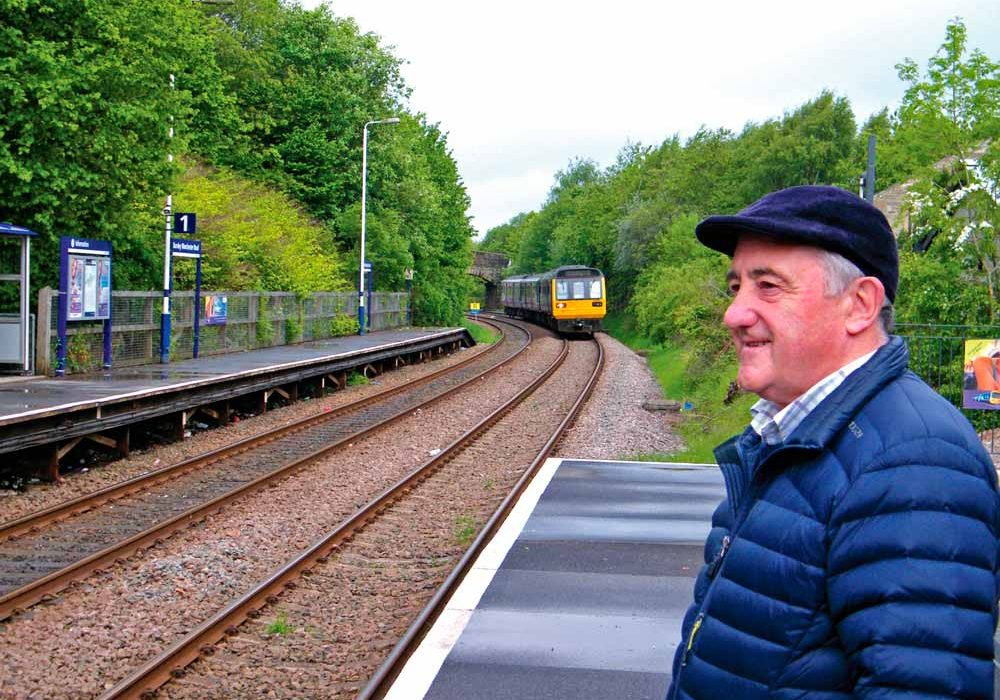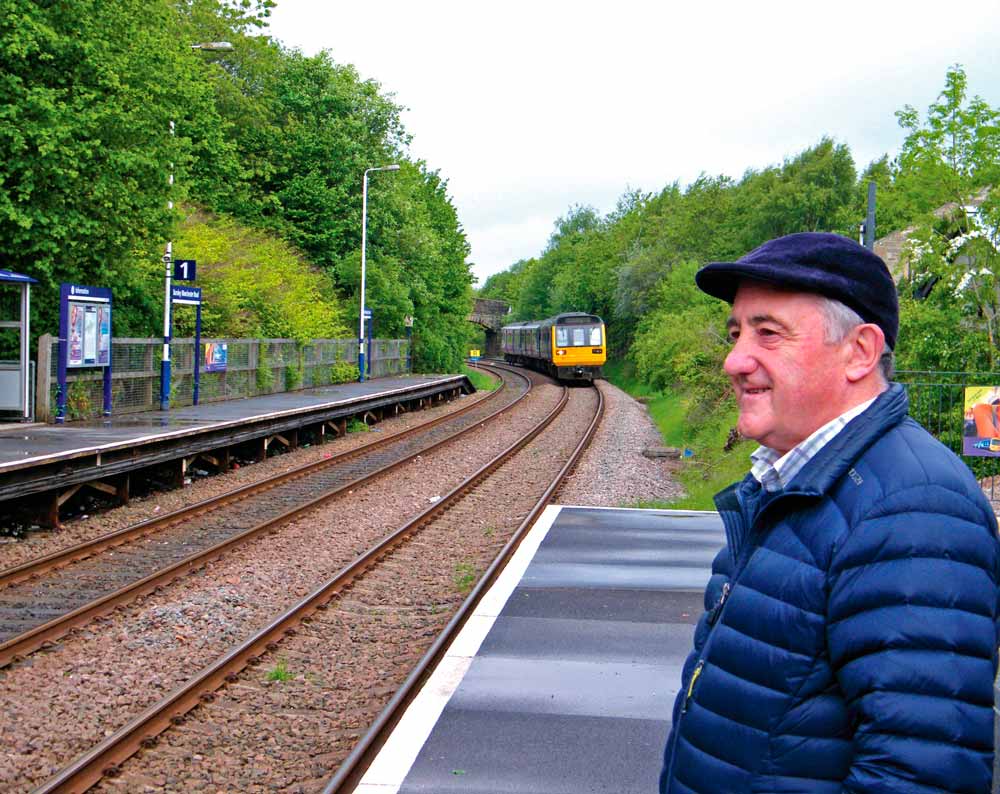
Taking the Todmorden Curve
by Northern Life

Colin and the train arriving at Manchester Road
We stood fidgeting on the station like schoolboys going on their first train journey. But my friend Colin is 77 and I am only two years younger.
Both of us have criss-crossed the country by train on various occasions but never had we travelled on the Todmorden Curve – that 440-yard section of track which closed in 1972.
Colin had never been on it despite living in Cliviger all his life, and I only moved to the village 12 years ago, long after Dr Beeching’s axe fell on that particular mini length of track in 1963.
We had both travelled up and down the Cliviger Gorge by car many times but seeing it from a different angle appealed.
We would end up in Manchester – via Burnley’s first direct rail link to the city since the original curve was removed – but that was little to do with our excitement. We had been there often. Even the delights of Todmorden were not part of our adventure. All we were interested in was that ten-mile section from Burnley’s Manchester Road station to where it crossed the border into Yorkshire and Todmorden.
As the train pulled into the station – a four-carriage job – we leapt aboard fighting for a window seat. I won by virtue of wielding the camera. Colin sat alongside me to highlight the route – a sort of Michael Portillo’s railway guide, but without the Bradshaw’s Guide. Bradshaw, in fact, described in reverse the route we were taking:
“This line curving gently to the left running through a deep glen, one side of which rises rather abruptly, but beautifully clothed with verdure, the other somewhat more open and undulating, with neat farmsteads and patches of green pasture and meadow land, intermingled with clusters of trees dotted over its sides to the summit.
“After passing the stations of Portsmouth and Holme a fine extensive tract of countryside opens out, presenting to our view the town of Burnley in the middle of the valley to our right, with Pendle Hill as a background.”

Winging towards Todmorden with the left tracks continuing to Hebden Bridge
As the train began its journey we passed the Hollywood Park Cinema Complex – unknown in Bradshaw’s 1866 volume – which site, my guide commented, once was a coal yard with wagons unloading tons of coal. Local merchants arrived and loaded it on to lorries for delivery locally.
Crossing the Hufling Lane level crossing (which was once operated by a signalman who Colin had, on occasions, seen turning a large wheel to open the gates which are now mechanical) we zipped by the site of Towneley Station – now no more – and into the tunnel underneath the Todmorden Road and on to the deep cleft on the edge of the Towneley estate.
Over the Iron Bridge – blocked at least twice in my time in Cliviger by drivers attempting to take a vehicle which was too high underneath – to and past the brick remains of what was the coal staithe, or loading area, for wagons from the Union Pit drift mine in Walk Mill.
Colin remembers well the constant rattle of buckets on the long conveyor contraption as they took coal to await the train.
A short distance from there is Holme Chapel, where a busy station once stood. Colin pointed out a small bridge marking a small track once providing a private road to the station for the occupants of The Holme, a magnificent mansion destroyed by fire in 2004, and at which Colin played his cornet each Christmas Day along with the Cliviger Prize Band to entertain the occupants.
Colin also explained how Holme station was the site of a tragic accident in 1907 when a train pulling about 40 wagons was derailed after the link connecting two wagons broke, sending a string of wagons careering down the steep incline into the back of the train, demolishing most of the buildings and killing the deputy station master, William Pim.
In fact another friend, Northern Life favourite Eddy Rawlinson, recalls the Cliviger Parish Council meeting many years ago when David Heginbotham (a former Burnley Mayor) made the first serious call for the reopening of the Todmorden Curve, a call he took to Burnley Council in 1993. Losing his seat the following year meant he was in no position to press the issue until he won the 1997 local election and resumed the battle – eventually hearing the council voting in favour. The issue was then taken up by local MPs and has finally brought fruit.
“Even members of own party said it would never happen,” he told me. “But I was determined to see it through.”
In fact now he wants to get the Holme Station reinstated and rebuilt. “I doubt it would attract many people from Cliviger and I admit that the more times the train stops the slower the journey. But I feel a few weekend trains stopping there would bring people to Cliviger.”

Todmorden, the unusual view from the viaduct
Passing through the Holme Tunnel, which was closed for five months from November 2013 for major remedial work, Colin told me of when the area was covered by Copy Pit and all the mining activity involved in that, including the thousands of tons of coal which must have been loaded on to wagons there.
The train progressed to what Colin, like other locals, called Windy Bridge, that kink in the road now marked on the road by traffic lights forcing motorists into a single file, and on the hills on the
right the beginning of two major rivers – the Yorkshire Calder, wending its way through Todmorden before joining the River Aire near Castleford, and the Lancashire Calder, wending its 15 miles in the opposite direction towards Burnley and on to join the Ribble.
Portsmouth is the next spot to win our attention, Colin saying that there was once a station there and for some time it was manned by a 19-year-old friend of his from school. He was an apprentice
deputed to work on the station to gain experience.
Further on was Cornholme, years ago, the site of another station, and then to the signal box manned by a signalman who was the husband of the midwife who delivered Colin. The signalman, he
said, was a Victorian-style father with three-daughters. Colin explained: “I knew him as Father Garrod and he was very strict and tough.”
There was one further station on the route to Todmorden – Stansfield Hall, which was closed during the Second World War. The other stations closed one after the other. Cornholme saw its last passengers in 1938, Portsmouth in 1959 and Burnley, Manchester Road in 1961 and Towneley in 1952 (after 103 years service) and Holme in 1930.
As the train moved into Todmorden for the remainder of the journey into Manchester we were able to recall some of the long history of the line once known as the Copy Pit Line because of its major task of funnelling thousands of tons of coal from the Burnley coalfields to other parts of the country quickly.
In fact the long haul from Todmorden to Burnley included a hefty climb, often involved the need for two steam locomotives because of the sheer weight of the wagons being moved.
It is a section of track long associated with problems. In 1845 when Mark Faviell was awarded the contract for a single track line, his contract for the nine-and-a-half miles his contract was £140,000.
- Holme Station in 1930 – from a Penine Parish
- Father Garrod – the signalman Colin knew
The following year the Railway authority announced it wanted a double track and added £66,000 to his contract. But two years later a cash crisis hit the authority and work was halted, to resume a year later with Faviell working on a single track but preparing the base for a double. The following year he was sacked and the rail company decided to finish the work themselves with the single track line operating in 1849 and the second track added ten years later.
Colin viewed our journey with fondness as his father, Jim, was a member of the gang of platelaters, or maintenance men, on the section of track from Walk Mill to Windy Bridge in the 1940s and 50s.
Beeching’s devastating, rail decimating report closed the line for passengers in 1965 and only political and business pressure have led to its reinstatement, bringing smoother journeys for many commuters and pleasure to many who simply enjoy a journey by train.
To some it is the just reward of years of arm twisting, complex political manoeuvres, and the input of £10m – which seems an enormous amount considering the short length of track involved.
But to Colin and myself it provided an opportunity to travel through the magnificent Cliviger Gorge along a different route. Long may it remain.






